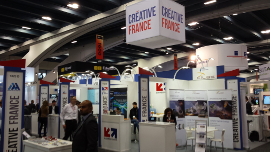Accueil
Photonics West 2017
- Détails
- Publié le vendredi 28 avril 2017 10:46

SPIE Photonics West took place from 28 January through 2 February. Approximately 23,000 scientists, researchers, engineers, students, and others from throughout the global photonics community were among the total attendance at San Francisco's Moscone Center for nearly 100 conferences and two exhibitions, complemented by a course program and numerous networking events.
More than 1380 exhibiting companies participated in the Photonics West Exhibition Tuesday through Thursday, with even more visitors than last year filling North and South halls to see what is new, including more than 200 new-product launches.
As in the past technical conferences were organized into BiOS, LASE, and OPTO topics, with more than 4700 presentations across more than 95 sessions, with applications tracks in 3D Printing, Brain, and Translational Biophotonics.
LASE @ Photonics West 2017
LASE − the conference dedicated to laser source technologies and industrial lasers and applications was opened and chaired by R. Poprawe (Fraunhofer ILT) and K. Sugioka (RIKEN). In total 654 presentations were announced in 4 sub-conferences with 17 sessions. Impossible to attend all or give a short resume here. It can be noted that fiber lasers, resonators and beam control as well as solid state lasers were the dominating sessions. French companies and researchers are well represented in almost all categories and the exhibition.
Photonics West continues to be THE networking event for those working in photonics.
OPTO @ PHOTONICS WEST 2017
The OPTO symposium was chaired by Shibing Jian (AdValue Photonics, USA) and Jean-Emmanuel Broquin (IMEP-LAHC, France). The topics include silicon photonics, MEMS-MOEMS, photonics crystals, optoelectronics, semiconductor lasers and LEDS, quantum dots and nanophotonics.
This year the OPTO plenary talks were focused on controlling thermal radiation, quantum dots and LiFi (light wireless communication). Shanhui Fan, from Stanford University, first show how to cool a building during the day. He and his colleagues used a structure made of a stack of dielectric that reflects the sunlight and emits infrared radiation towards the sky in the 8 to 14 microns range, where the atmosphere is transparent. The universe is used as a heat sink, and he demonstrated cooling at a temperature below 0 °C. Fan also shown that this could be adapted to cool photovoltaic cells, which efficiency drops with the temperature. The stack of dielectric layers does not reflect any more the solar spectrum but transmit it to the photovoltaic cell.
Dieter Bimberg (Technische University, Berlin) plenary talk was focused on the fabrication and practical use of quantum dots in the context of quantum encryption as well as lasers and amplifiers. As he detailed, a quantum dot can emit one or two entangled photons. A LED with a single quantum dot can act as a qubit emitter, and be used in every quantum cryptography processes. A set of quantum dots, with various shapes and sizes can also be used in lasers to broaden the emission of lasers and deliver shorter pulses. Eventually, Dieter Bimberg describe how quantum dots can be used in network amplifiers to decrease their cost and their energy consumption.
The last plenary talk was given by Harald Haas (University of Edinburgh), on the possibilities of using LiFi, i.e. wireless communications using visible light. He has made some pioneering work on this promising technology, demonstrating high data rate transmission using LEDs and classical visible detectors. Harald Haas also reviewed some of the common misconception on LiFi, in particular its compatibility with the primary lighting functionality of LEDs and the possibility to transmit data with retro diffused light. He also details his vision of the implications of this technology in the future, and how it can be integrated with public lighting.
P. Bouchon, W. Knapp






